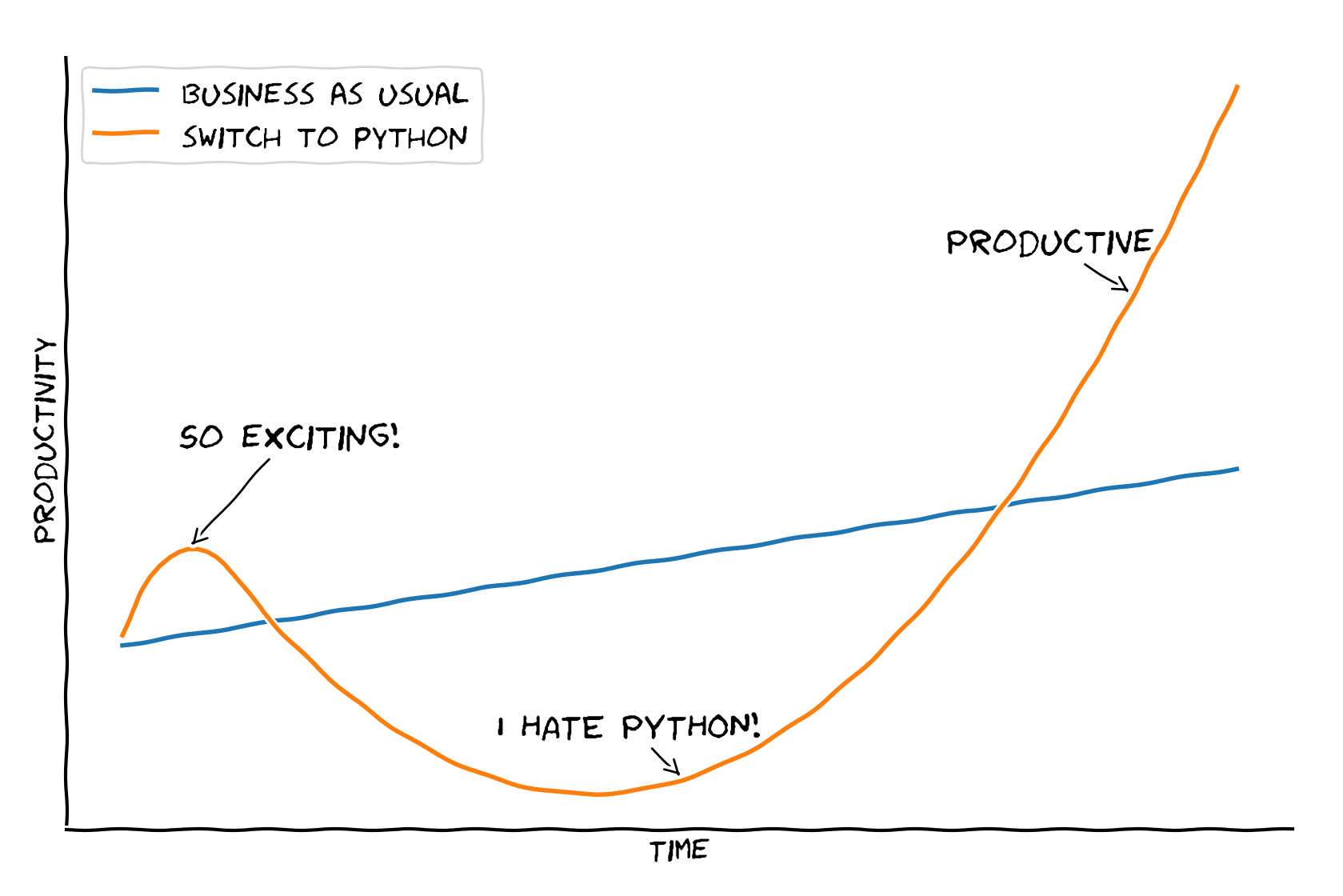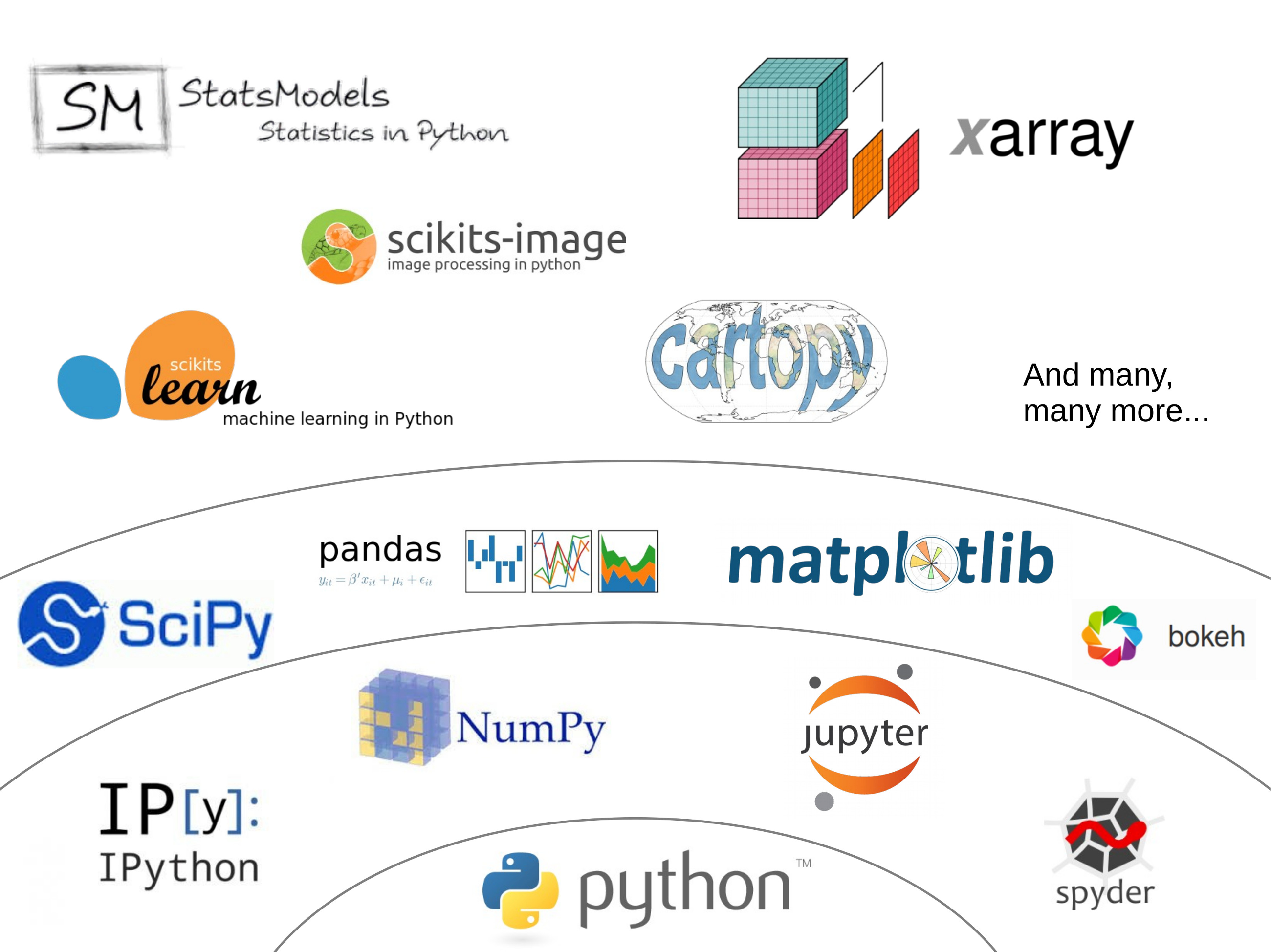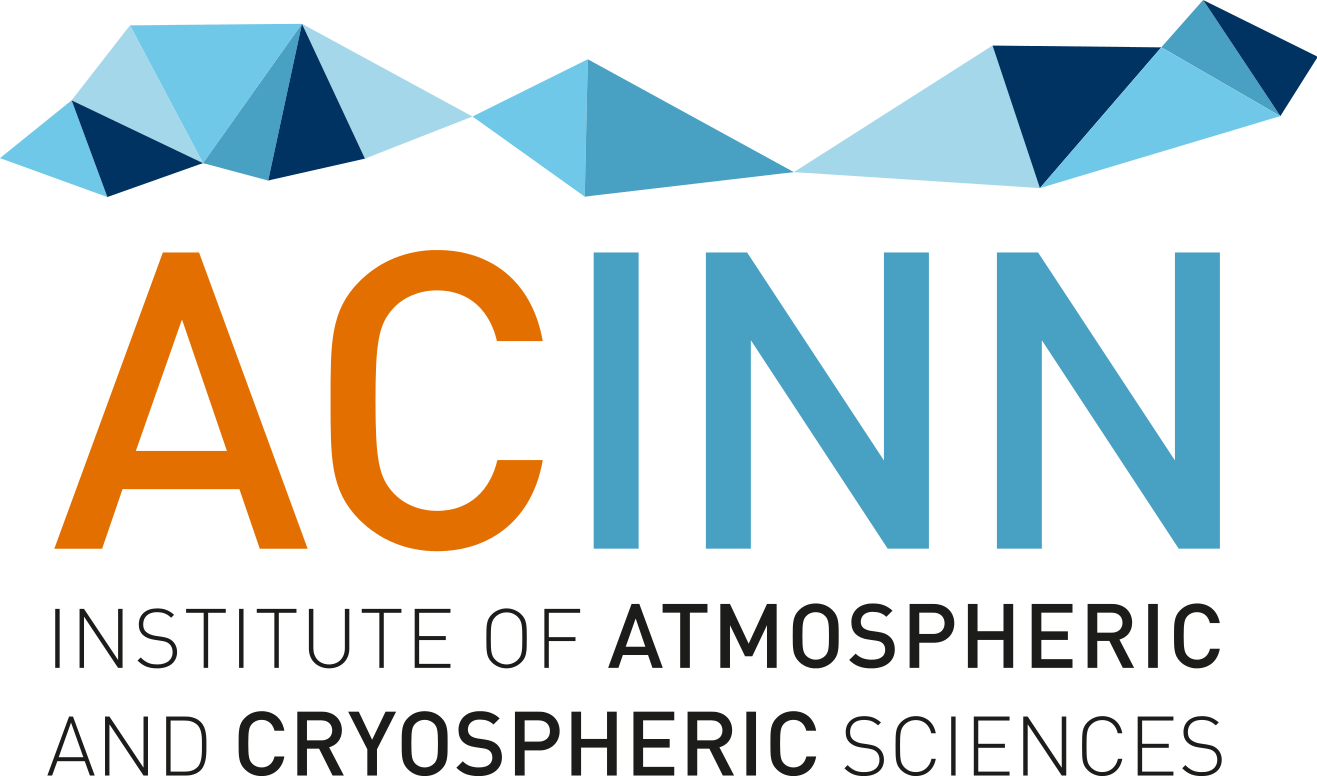Outline¶
- Why this workshop?
- Switching to python: benefits, drawbacks and pitfalls
- Getting started
- Major differences with other languages
- The scientific python ecosystem
- Installing Python
- Integrated development environment
- If interest:
- discover Python with the Notebook
- install party!
Why this workshop?¶
- Helping beginners or long-time matlab/R users to make the first steps towards python
- There are plenty of good Python tutorials online, but some information is outdated and confusing: this is less a problem for the syntax (which doesn't change) than for the python installation (which has greatly improved in the last months/years)
- Synergy effects: shared tools and methods ⇨ more efficient research
What is this workshop not supposed to be?¶
- a course about the Python syntax
- Matlab/IDL/R bashing
- a monologue
Switching to python: benefits¶
- free and open-source
- powerful, all-purpose language with a great syntax
- scientific ecosystem and large user base (including ACINN)
- "low-risk investment": python is going to stay around for a while
- Open-source (including Python) is the future of scientific research (keyword: open science)
Switching to python: drawbacks¶
- learning curve can be steep when coming from IDL/Matlab
- your existing tools will be difficult to translate
- many (many) tools & packages of variable quality: not easy to know which to use
- not always consitent: doc for packages spread on various websites, learning without internet almost impossible
The three stages of the transition¶

Avoiding pitfalls¶
- Be patient: do not expect to be productive on the first day (and not on the first week either)
- DO NOT translate your existing code: pick a new project instead (i.e. for a new dataset you are analysing, a new paper you are writing)
- Get some help when frustration kicks in
- Python is no golden egg: a transition must be planned and might not always be the best move for your project/career/etc.
Major differences with other languages¶
- Syntax (of course)
- The
importmechanism
- No "all-in-one" development environment like Matlab
- Out of the box, Python is no good for science
a = [1, 2, 3]
a + a
[1, 2, 3, 1, 2, 3]
a * 4
[1, 2, 3, 1, 2, 3, 1, 2, 3, 1, 2, 3]
The scientific python ecosystem¶

import numpy as np # central tool for vectorized operations
a = np.array([1, 2, 3])
a
array([1, 2, 3])
a * 4
array([ 4, 8, 12])
from scipy.interpolate import interp1d # scientific "toolbox"
import matplotlib.pyplot as plt # plotting like in matlab
x = np.linspace(0, 10, num=11, endpoint=True)
y = np.cos(-x**2/9.0)
f1 = interp1d(x, y)
f2 = interp1d(x, y, kind='cubic')
xnew = np.linspace(0, 10, 101, endpoint=True)
plt.plot(x, y, 'o', xnew, f1(xnew), '-', xnew, f2(xnew), '--')
plt.legend(['data', 'linear', 'cubic'], loc='best');
Installing python¶
Python 2 or Python 3?¶
Short answer: use Python 3
Long answer: there is absolutely no reason for a beginner to use Python 2. The Py2/Py3 problem is unfortunate, but Python 3 is better in all aspects. The only reason why people still use Python 2 is when they have a heavy bagage of old (untested) code.
*If you need to use a software which is py2 only, try to contact the author of the package (or use another package).*
Installing Python: the complicated way¶
- On windows: go to the python webpage, download python, etc.
On linux/mac, python is installed per default
But ... how to install the packages?
apt-get install numpywill work, but it will be outdated and the installation is frozen
Installing Python: the recommended way¶
Use the conda package manager, installed via miniconda
- platform independant
- fully operational python installation in one single directory
- installing new packages is easy
- beginner friendly: it is impossible to break anything. In case of doubt, delete the install directory and see what happens (answer: not much).
conda: getting started¶
Download: https://conda.io/miniconda.html
Installation: https://conda.io/docs/install/quick.html
Tutorial: https://conda.io/docs/test-drive.html
First thing to do after install:
conda config --add channels conda-forge
conda forge is the best source for scientific python packages.
Virtual environments¶
import xarray
xarray.__file__ # tells me where the file is located
'/home/mowglie/.bin/conda/envs/python_demo/lib/python3.5/site-packages/xarray/__init__.py'
- isolated environments where you can play around and brake things if you want
- allows to install different package versions at the same time
- become more useful with time
pip, conda, or both?¶
pip is the standard (traditional) way to install python packages. It works well for pure python packages, but is limited when it comes to complex packages with non-python dependencies (e.g. NetCDF, GDAL...).
Conda will install binaries, meaning that it will ship with all packages dependencies in the same bundle.
The good news is that pip install my-special-package will work in a conda environment! This is not true the other way around (pip doesn't know about conda), and in general you shouldn't use pip yourselves (unless the package you want to install is not on conda).
Some of my favorite packages¶
pandas : working with tabular data
import pandas as pd
ts = pd.read_csv('GLB.Ts+dSST.csv', index_col=0, header=1)['J-D']
ts.plot(label='Annual T')
ts.rolling(window=31, center=True, min_periods=1).mean().plot(label='30-yr avg')
plt.legend(loc='upper left');
xarray: pandas, but for N-Dimensions and netcdf files
import xarray as xr
import cartopy.crs as ccrs
air = xr.tutorial.load_dataset('air_temperature').air
ax = plt.axes(projection=ccrs.Orthographic(-80, 35))
air.isel(time=0).plot.contourf(ax=ax, transform=ccrs.PlateCarree());
ax.set_global(); ax.coastlines();
⇨ Workshop next week!
scipy: all the scientific stuff
matplotlib: plotting à la Matlab
cartopy: plotting on maps
salem: projection transformations and WRF files
statsmodels and scikit-learn: statistical models and machine learning
...
Developing in Python¶
Demo: notebook, first module
"Advanced" IDE: pycharm (free version)
(my personnal choice over spyder)
Thanks for your attention!¶
Questions?
Discussion:
- should we set-up a mailing list for programming related questions?
- would there be interest for another workshop of this type? About what?
- how can we coordinate our efforts for better software practices?
Let's get our hands dirty!¶
Install python on your laptop: https://github.com/fmaussion/teaching/blob/master/install_python.rst
Install python on the computer room (linux terminal):
$ gedit ~/.bashrc
At the end of this file, add the following two lines:
# added for Fabien's course:
export PATH="/scratch/c707/c7071047/miniconda3/bin:$PATH"
Download the "getting started" notebook:
https://raw.githubusercontent.com/fmaussion/teaching/master/python_intro_acinn/Getting_Started.ipynb (use "save link as")
Start the notebook interface:
$ jupyter-notebook
</small>
